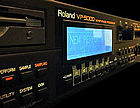| |
| INTRODUCTION |
 |
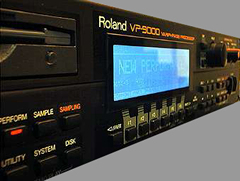 |
It
is quite difficult to include the VP-9000 in any of the current
categories of products, being an innovative device in the stand-alone
digital instruments area.
Undoubtely, it provides some features previously offered only by
computer-dedicated softwares. At the same time, additional advantages
are available: fast operativity, intuitive user interface, real-time
control and easy carriage.
The VP-9000 cannot be considered just as a sampling-based audio
processor. In fact, it overcomes many problems that conventional
samplers have in handling audio phrases.
Usually, working with a sampler, two operations should be done:
- multisampling, to have an homogeneous timbre across the keyboard
- time-stretching, to increase/decrease the sample lenght (let's
say a musical phrase) to keep the required playback speed.
These operations always require a lot of memory and are time-consuming
in terms of programming, to the detriment of the possible live real-time
use.
A single sample can be processed by the VP-9000 to be played back
across a wide range of keys in real-time retaining the original
tone, envelope and tempo. On the other hand, it is also possible
to change the sample playback speed without changing the Pitch or
to change the Pitch without changing the Tempo.
So, under a certain point of view, the VP-9000 it's a world a part.
 Technical
Details Technical
Details
 V-Producer
Overview V-Producer
Overview
|
| MAIN
PLUS |
 |
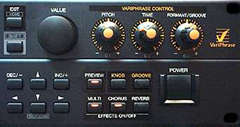 |
The
VP-9000 is a stand-alone system that allows to change sample's Pitch,
Time, Formant and Groove in real-time.
Basically, it's a musical instrument that is a computer in disguise.
Due to this, it combines power and flexibility with user-fliendly
operativity and easy carriage.
Here below, some technical details are listed:
Polyphony and multitimbral capability.
The VP-9000 can hold only one Performance in its internal memory.
A Performance can also be automatically loaded when the power of
the unit is turned on.
A Performance includes 6 Parts. Some parameters have a single setting
for the whole Performance, while others can be set independently
for each Part.
One of the most important is the Keyboard Map, that sets the state
of the control keyboard for each Part.
Three modes are available:
-Normal: the sample assigned to each Part can be played at the pitch
of each key.
-Event: the sample is divided into the component "events", each
one assigned to a different key ("Events" are locations wirhin a
sample - i.e.: a musical phrase - automatically detected and marked
where there is a strong attack during the encoding process).
-Phrase Map: up to 12 samples can be assigned to different keys
of a Part, setting an independent level, pan and tuning for each
one.
In any case, the VP-9000 can always produce a maximum of 6 notes
(voices) simultaneously. Maybe, this is the only limit that can
be currently pointed out, expecially if the unit is used to reproduce
some musical instruments (i.e.: piano) instead of being considered
as a controller/processor of recorded phrases.
|
| |
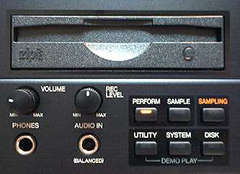 |
Internal
memory and data management.
The VP-9000 features an 8 Mb internal RAM that can be expanded up
to 136 Mb installing optional SIMMs (4 slot x 32 Mb SIMM). With
8 Mb of internal wave memory, the unit provides 25 seconds of stereo
sampling or 50 seconds of monoaural sampling @ 44.1 kHz sampling
frequency.
Being a sampling-based device, the memory available onboard by default
could be considered insufficient. Nevertheless, it should not be
forgotten that multisampling is not required.
A single sample can be assigned to a wide range of keys. Referring
to the mass storage, the built-in Zip driver (250 Mb disks) allows
an easy data saving/loading. 100 Mb disks can also be used.
No problems have been pointed out except for an increased saving/loading
time. Moreover, the WAV and AIFF format compatibility provides an
useful computer interaction, allowing an useful audio samples sharing.
At last, two SCSI ports are built-in providing a wide range of possibilities
in terms of data backup external units connection.
|
| |
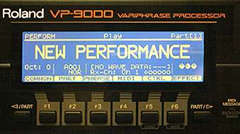 |
User
interface.
This is one of the most agreeable features of the system. The graphic
display user's interface is based on easy-to-understand icons, that
avoid the necessity of written messages.
This is very helpful in performing the operativity procedures.
|
| |
 |
Samples
Editing and VariPhrase Encoding.
The VP9000 provides a wide range of sample's editing functions.
In SAMPLE mode it is possible to change the original Tempo and the
Pitch of the sample. It is also possible to change its name and
to assign it to an instrumental category (38 available), for a quick
selection. The sample can be played both monophonically and polyphonically.
Moreover, the SAMPLE mode allows to choose different playing modes
(Retrigger, Time sync, Legato or Step) and to switch on/off the
Loop, Trigger Quantize and Robot Voice functions.
Basically, the "hearth" of the VP-9000 is the ENCODE function that
process the samples with a sort of "elastic" audio data management.
It's really astonishing to check the sample quality and timbre (after
encoding), by changing the pitch or the playback speed with the
VariPhrase knobs.
This is much more evident when the sample is played by MIDI keyboard.
The "chipmunk" effect desappears.
Very interesting is also the possibility to easily synchronize samples
with different Pitch and Tempo.
|
| |
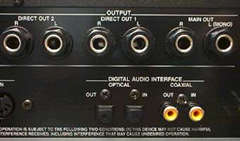 |
Effect
section and Output management.
A Multi-effects section (providing 40 different algorithms), a Chorus
(8 types) and a Reverb (9 types) are built-in (24-bit processor).
A wide range of sound processing possibilities are also provided.
The built-in Multieffect, in fact, includes some COSM technology
algorithms (Guitar Amp simulator, Space Chorus, Analog flanger,
etc.). At last, the VP-9000 is equipped with 3 independent Stereo
outputs.
|
| |
| INTERNAL
ARCHITECTURE |
 |
 |
The
VP-9000's structure is quite easy to understand allowing an immediate
operativity.
Samples can be played in the Performance mode. A Performance includes
6 Parts. Each Part can be assigned to a specific range of keys.
A Part can include up to 12 Phrases (samples).
With reference to the Outputs, a specific display page allows to
assign the Parts to each Stereo pair (Main, Direct 1, Direct 2).
|
| |
| CONCLUSIONS |
 |
| |
There's
no doubt that the VP-9000 is a breakthrough in the hardware sampling-based
units category. It's something new like the first sampler has been
in the early '80s.
The VP9000 is in fact a possible evolution of the original sampler,
offering a lot of new interesting features. Anyway, the innovation
provided by this device should be deeply analyzed.
Currently, in fact, the question to point out is how to use proficiently
the VP-9000 for studio and/or live applications. The sure thing is
that the VP-9000 features can inspire new ways to use sampling technology
and, from this point of view, the quality/price ratio can be considered
convenient.
Finally, something about the learning support: the VP-9000 is provided
with a User Guide and a Zip Demo disk that are both very useful to
understand the basic feataures of the unit. |
|
|
|
 |



